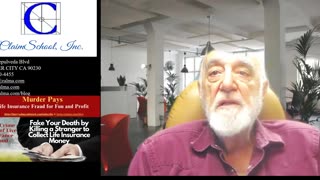Premium Only Content

True Crime of Insurance Fraud Video Number 77
This One Isn’t Fiction Because No One Would Believe It
I received a copy of findings of fact and conclusions of law in a case filed in the U.S. District Court for the Central District of California entitled CIGNA Property and Casualty Insurance Company v. Polaris Pictures Corporation, U.S. Inbanco, Ltd., Continental Pictures Corporation, Paul Ebeling, Kendall Earl Capps, Adrien Wirz, and Jacob Wizman there docketed as case number CV 93-2259 JSL.
On February 20, 1997 United States District Judge J. Spencer Letts found a lawyer and others had committed fraud and purchased a policy of Marine Insurance for the sole purpose of sinking a boat. The findings of Judge Letts read better than I could ever imagine. Here are parts of what Judge Letts concluded:
The evidence presented to the court …convinces the Court that, according to the overwhelming weight of the evidence, that defendants Polaris Pictures Corp. (‘Polaris’), and U.S. Inbanco Ltd. (‘Inbanco’), … conspired with at least one of the named defendants in this action, and a non-party lawyer (the ‘lawyer conspirator’), to engage in a very sophisticated fraud to collect insurance proceeds from plaintiff, Cigna Property and Casualty Insurance Company (‘Cigna’), a marine insurer.
In essence, the fraud intentionally concealed from Cigna the material fact that the conspirator’s purpose in purchasing the insurance from Cigna was not to protect themselves against the risk of an unknown future event, but rather to precipitate an accident which would allow them to collect on it. As a result, a judgment of rescission of [the policy] … issued to Polaris and Inbanco is warranted.…
On June 9, 1992, the lawyer conspirator signed an Order Contract to purchase a brand new 76’ Azimut motor yacht for $1.9 million.
Prior to June 1992, the lawyer conspirator had sustained three total losses of yachts that he either owned or held ownership interests in. Each of these prior yacht losses was insured and each prior yacht loss was paid in full by the respective insurer.
The lawyer conspirator then arranged for Continental to ‘sell’ the yacht to Polaris. The Continental-Polaris transaction was a stock transaction between a company about which little evidence was presented (Continental) and a company with virtually no assets (Polaris).
Polaris was formed by the lawyer conspirator and completely controlled by him at all relevant times. It was also located at the same address as the lawyer conspirator’s residence.
The evidence showed that Polaris never did business of any kind or substance. In addition, the evidence showed that Polaris was placed between the principals of this fraud as a diversion in order to disguise the identity of the person who would get the money in the event of a loss – namely, the lawyer conspirator.
[T]he court finds that defendants’ fraudulent scheme consisted in part of using the insurance proceeds to pay to Inbanco, as a ‘creditor,’ the sham ‘debt’ secured by the vessel.…
[T]he court finds …a conscious plan to defraud Cigna by temporarily distancing the lawyer conspirator from Polaris until the insurance proceeds had been paid.… “All of the ostensible transactions discussed above, with the exception of the purchase of the boat, were among parties all closely tied to the lawyer conspirator, and the corporate parties did not have any meaningful assets.
[T]he reason the lawyer conspirator took such extensive measures to distance himself from these corporations and transactions was to divert attention away from his own personal loss history of sinking vessels.…
Polaris and Inbanco eventually purchased marine insurance for the yacht, named “Principe Di Pictor,” from Cigna… The Application [for the insurance] also failed to state the material fact that Polaris and Inbanco’s purpose for purchasing this insurance was to collect on it, and that a preplanned event for the destruction of the yacht and collection of the insurance was soon and certain to occur. …
The yacht was scuttled on November 7, 1992 [two weeks after the policy was issued] off the Coast of Italy during its maiden voyage. The lawyer conspirator … [was] on board at the time.…
The account of the scuttling from the lawyer conspirator … was that the yacht, allegedly worth $3.5 or $3.62 million, and the lives and bodies of the people on it, was entrusted to a person met for the first time in a dockside restaurant in Naples. This person, whose documents were written in a foreign language, brought with him two other persons who did not speak English and six black duffel bags with undisclosed contents. The three strange men were allegedly applicants for the jobs of Captain and crew.
The Court finds defendants’ claim …to be wholly preposterous. The Court finds the account of the scuttling so incredible that standing alone it would raise serious questions as to whether the boat was deliberately scuttled.…
[P]urchasing insurance, not for the purpose of insuring a risk, but rather for the purpose of collecting the insurance for an event that is being planned, is a highly material fact that should be stated to the insurer.…
The lawyer conspirator was without any credibility as a witness, and he looked, acted and sounded very much like a conspirator in a dishonest scheme. …The lawyer conspirator’s testimony was not cogent and his financial records were very difficult to follow.
The news report did not name the lawyer conspirator. I had dealt with him several times with regard to fraudulent insurance claims so I called the trial lawyer and just asked:
“Is the lawyer conspirtor’s name Rex?
The trial lawyer, Neil S. Lerner was shocked. “How did you know?”
I explained my history with lawyer Rex and wanted to thank Mr. Lerner and all the lawyers at Sands Narwitz Forgie Leonard & Lerner who tried the case on behalf of CIGNA, for finally defeating a fraudulent claim presented by Rex, a long-time nemesis of the insurance industry in California.
I also wish to thank Judge Letts for seeing through an insurance fraud and recognizing that an insurance company can be a victimized by an insured. At the direction of Judge Letts, the lawyer – Rex DeGeorge – was prosecuted by the U.S. Attorney and convicted of mail and wire fraud.
He is now serving a long sentence in federal prison.
ZALMA OPINION
This case is important, and unusual, because it affirmed a rescission based on blatant fraud in obtaining insurance that allowed the insurer, CIGNA, to rescind the policy from its inception. It is more important because the Judge Letts referred to the U.S. Attorney the conspirator who was arrested, tried, convicted and sentenced to federal prison for fraud. Although I held out hope for other judges to emulate Judge Letts, but I have been disappointed.
(c) 2022 Barry Zalma & ClaimSchool, Inc.
Barry Zalma, Esq., CFE, now limits his practice to service as an insurance consultant specializing in insurance coverage, insurance claims handling, insurance bad faith and insurance fraud almost equally for insurers and policyholders. He practiced law in California for more than 44 years as an insurance coverage and claims handling lawyer and more than 54 years in the insurance business. He is available at http://www.zalma.com and zalma@zalma.com.
Subscribe to Zalma on Insurance at locals.com https://zalmaoninsurance.local.com/subscribe.
Subscribe to Excellence in Claims Handling at https://barryzalma.substack.com/welcome.
Write to Mr. Zalma at zalma@zalma.com; http://www.zalma.com; http://zalma.com/blog; daily articles are published at https://zalma.substack.com. Go to the podcast Zalma On Insurance at https://anchor.fm/barry-zalma; Follow Mr. Zalma on Twitter at https://twitter.com/bzalma; Go to Barry Zalma videos at Rumble.com at https://rumble.com/c/c-262921; Go to Barry Zalma on YouTube- https://www.youtube.com/channel/UCysiZklEtxZsSF9DfC0Expg; Go to the Insurance Claims Library – https://zalma.com/blog/insurance-claims-library/
-
 13:02
13:02
Barry Zalma, Inc. on Insurance Law
1 year agoMurder Pays
4271 -
 12:14
12:14
Nikko Ortiz
1 day agoMilitary Fails Of The Week
13.2K12 -
 1:16:31
1:16:31
Omar Elattar
9 months agoThe Untold Story: How Vans Became a $3 Billion Dollar Shoe Empire In 75 mins
19.9K8 -
 LIVE
LIVE
LethalPnda
2 hours agoLocked & Loaded! 🔥 Fate Trigger Beta #RazerCreator #SpacePanda @Mystivis
76 watching -
 LIVE
LIVE
BigDaddySlick78's Live Gaming Channel
2 hours ago💰I Pay You To Play Call of Duty Warzone Rebirth Island LIVE #callofduty #warzone #cod #gaming
45 watching -
 1:59:43
1:59:43
Side Scrollers Podcast
2 days agoRIP Hulk Hogan + Payment Processor CENSORSHIP Has Officially Begun + More | Side Scrollers
174K13 -
 LIVE
LIVE
Lofi Girl
2 years agoSynthwave Radio 🌌 - beats to chill/game to
285 watching -
 1:56:31
1:56:31
The Pascal Show
19 hours ago $6.35 earnedGHISLAINE FLIPS?! DOJ Receives SECRET LIST of 100 Epstein Associates!”
17.4K7 -
 10:17
10:17
Dr Disrespect
11 days agoIt's Time To Get Serious
186K31 -
 2:15:09
2:15:09
Badlands Media
1 day agoDevolution Power Hour Ep. 375: Obama’s Orders, Ukraine’s Collapse & the Inversion of Justice
309K122